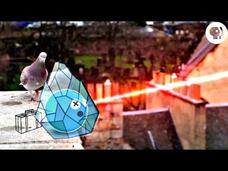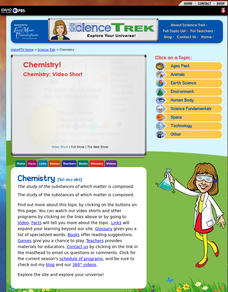Physics Girl
How Does Laser Cooling Work?
We typically think of lasers adding heat energy, but lasers can be used for cooling, too! An episode of a physics playlist discusses the science of lasers. Learners watch how to place lasers to effectively slow subatomic particles.
Mystery of Matter
Mysteries of the Periodic Table, Part 1: A Reflection of the Atom
Properties of atoms are no small thing. A thorough video lesson describes properties of atoms and how they relate to the makeup of the periodic table. Learners review the relationship between subatomic particles and discover the...
Mystery of Matter
Mysteries of the Periodic Table, Part 2: The Rare Earths
Seeing is believing, but seeing is difficult when identifying elements by their subatomic particles. Learners take a trip through history to identify the rare earth elements to learn the struggle of separating the very similar elements....
TED-Ed
The High-Stakes Race to Make Quantum Computers Work
Quantum mechanics just might take computing to a new level. Pupils watch an animated video to learn about quantum computers and how they differ from classical computers. They learn about two current approaches to quantum computing,...
Fuse School
Question - Matter Exam Question 2
Looking for a great way to see what young chemists know about atomic structure? In the 14th and final installment in the states of matter series, learners put their skills to the test. The four-part question covers placement of subatomic...
Fuse School
Question - Matter Exam Question 1
How much does your class know about subatomic particles? Module 13 in a 14-part series tests their knowledge of how to determine an atom's number of protons, neutrons, and electrons when given the atomic number and the mass number....
SciShow
Weak Interaction: The Four Fundamental Forces of Physics #2
Scientists can't just change a neutron to a proton, can they? Although they don't have control of this process yet, they have identified the weak force that does exactly that. The simple graphics in an interesting video explain the...
TED-Ed
Einstein's Brilliant Mistake: Entangled States
Mistakes aren't always a bad thing. Learn how one of Albert Einstein's greatest contributions to the field of quantum physics was actually a theory that ended up being proven wrong, with this short video on entangled states.
Be Smart
How to See Time Travel!!!
Are you ready to take your learners on a time travel exploration? The short video segment uncovers the nuances of time travel and the scientific theories behind this sometimes misunderstood activity. Learners conclude with a discussion...
Bozeman Science
PS1A—Structure and Properties of Matter
It's time we get to the heart of the matter! Explore standard PS1A in an informative video. The narrator guides viewers through the basic ideas of the structure and properties of matter. then discusses helpful strategies for...
Be Smart
What's the Hottest Hot and Coldest Cold?
When temperatures get extreme, physics gets a little weird! Show physics scholars the lowest man-made temperature to date, as well as the extreme heat of the Big Bang using a video from an extensive playlist. The narrator explains some...
SciShow
Great Minds: Richard Feynman, The Great Explainer
Who is known for his bongo playing and solving the hardest algebra problem of all time? Richard Feynman loved to solve puzzles and didn't handle being bored very well. He is known for the Feynman diagrams that explain quantum...
TED-Ed
What Are the Challenges of Nuclear Power?
Engineering challenges, construction costs, and disasters are some of the challenges when it comes to nuclear energy. Watch a video that explains each of these and more in detail.
Crash Course
Neutron Stars
This is one heavy video! Introduce the topic of neutron stars with a brief but informative resource. Young astronomers discover the history of neutron star research, the conditions present in and around a neutron star, and the...
MinutePhysics
How to Teleport Schrödinger's Cat
Teleportation is possible! An artistic video lesson discusses three types of quantum teleportation. The narrator explains what is possible and what is not before giving real teleportation examples.
Veritasium
Galaxies From Nothing
Space can never be truly empty because fields occupy the seemingly empty space. Another installment of the Veritasium playlist attempts to explain the science of the creation of the galaxies. By referencing the quantum fluctuations, the...
JFR Science
Representing the Atom: Bohr, Rutherford and Lewis Diagrams
What's the best way to draw an atom? Well, that depends on what information you need to convey. Compare and contrast the atomic models of Bohr, Rutherford, and Lewis using a video from the JFR Science series. The resource shows the basis...
PBS
Science Fundamentals: Chemistry!
Chemical reactions are a part of almost everything in everyday life. A video presentation gives an introduction to chemistry by describing the basics of atomic structure and chemical reactions. Learners discover chemical reactions are...
MinutePhysics
Theory of Everything: What is Matter?
Ever wonder why matter, well, matters so much? In the follow-up to the Theory of Everything video, pupils discover how the Pauli Exclusion Principle, which governs electron behavior, ultimately dictates how matter throughout the universe...
Veritasium
Can We Really Touch Anything?
When we touch something, what actually happens? Young physicists get in depth with electrons in a video from Veritasium. The narrator first explains the intricate interactions that occur at the subatomic level before answering a variety...
Ricochet Science
Structure of an Atom
Just because we can't see an atom doesn't mean we can't study it! The video examines the makeup of the atom. It explains the roles of the protons, neutrons, and electrons.
MinutePhysics
Faster Than Light Neutrinos (Maybe): Field Trip!
Walk in the shoes of a research scientist. A short video describes the hurdles necessary to prove that neutrinos are faster than light. The narrator describes the initial experiment and the follow-up research necessary to support the...
Domain of Science
The Map of Physics
Aristotle said, "The more you know, the more you know you don't know." Physics includes everything from the laws of motion to quantum gravity. An interesting video attempts to cover the main concepts of every branch of physics in only a...
Curated OER
Junior Chemistry: The Periodic Table, Part 2/2
Chemguy uses diagrams on his whiteboard to describe the structure of an atom. In a second segment, he explains what an isotope is with an example. That is all there is to this presentation. Its brevity allows you to include it as a link...

























